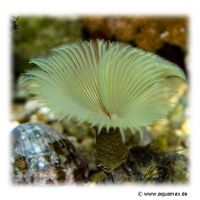Fan Worm Yellow (Sabellastarte sp. 'Yellow')
| Fan Worm Yellow Sabellastarte sp. 'Yellow' | |
|---|---|
| Name | Fan Worm Yellow |
| Name Lat. | Sabellastarte sp. 'Yellow' |
| Family | Feather Duster Worms |
| Family lat. | Sabellidae |
| Order | Feather Dusters |
| Order lat. | Sabellida |
| Origin | Indo-Pacific |
| Diet | Planktivore |
| pH | 8.1-8.4 |
| Hardness | 8-10 °KH |
| Lighting | Medium |
| Current | Weak-moderate |
| Behavior | Peaceful |
| Keeping | Solitary, colony |
| Care Level | Moderate |
| Life Span | N/A |
| Protection | No |
| Metric Units | |
| Size | 20 cm |
| Temperature | 24-28 °C |
| Salinity | 33-36 ‰ |
| Aquarium | 200 l |
| US Units | |
| Size | 7.9" |
| Temperature | 75-82 °F |
| Salinity | 1.020-1.025 sg |
| Aquarium | 50 gal |
Distribution and habitat
The Sabellastarte sp. "Yellow" are widely distributed in the Indo-Pacific. They live in self-made, parchment-like living tubes and settle on different substrates up to a depth of 15 m on the coral reef.
Maintenance
They should be carefully wedged between stones or buried at an angle in the substrate in a location with low light and low current. Stony corals as co-inhabitants in the aquarium are advantageous
Only substrates rich in lime and free of heavy metals may be used as substrate. To ensure water quality, filters, skimmers and heaters are necessary, as well as pumps to simulate tides, swells and bottom currents. It is recommended that live stones be used to set up the aquarium. The bacteria living in the porous stones act as a biological filter. The lighting must correspond to the species-appropriate day-night rhythm of the animals
| Salinity: 33-36 ‰ | pH value: 8.1-8.4 |
| Carbonate hardness: 8-12 °KH | Nitrate content: 2-8 mg/l |
| calcium content: 420-450 mg/l | Nitrite content: 0.0-0.05 mg/l |
| Magnesium content: 1.250-1.350 mg/l | phosphate content: 0.01-0.1 mg/l |
Regular addition of trace elements, especially calcium, is recommended. For salinity, an average value should be aimed for, which may only vary slightly by +/- 0.5 ‰. Ammonia and ammonium must not be measurable. Special attention shall be paid to consistently good water quality and water values.
Diet
In nature they feed on microplankton and detritus. Even in a well acclimated aquarium, additional feeding is usually unavoidable. They should be fed directly and specifically (pipette) several times a week with Artemia nauplii, Cyclops, lobster eggs as well as zooplankton and live phytoplankton, which is available as ready-made food in specialized shops.
Regular and varied feeding promotes health and prevents deficiency symptoms.
Behaviour and compatibility
They can be well socialized with fish and lower animals that do not consider their polyps food (e.g., angelfish or butterflyfish).
Reproduction and breeding
Little is known about reproduction. They produce male and female gametes simultaneously, which are released into the surrounding water. Reports about successful reproduction in the aquarium are not known.
Important
In their distribution area there are numerous differently colored animals. An exact determination on the basis of the tentacle crown is not always possible.
During transport and relocation care must be taken that no air gets into the tube
If disturbed, they retreat into their tube as fast as lightning. Under unfavorable husbandry conditions (stress situation, lack of food) the tentacle head can be thrown off. However, healthy animals soon regenerate it. It can also happen that they leave their living tube to build a new one in a few hours or days.
Newly introduced animals must be acclimated slowly to the water in the aquarium. If different species are kept together, care must be taken to ensure that fish and invertebrates match each other in terms of water quality and temperature requirements, as well as their social behavior, and that the setup meets the ecological needs of all species kept together
Further literature can be found in your pet store.
References
Text: petdata; Image: www.aquamax.de
Source: ERHARDT & MOOSLEITNER (1997): Meerwasser Atlas Bd. 3, Mergus Verlag; ENGELMANN & LANGE (2011): Zootierhaltung - Tiere in menschlicher Obhut: Wirbellose, Verlag Harri Deutsch
